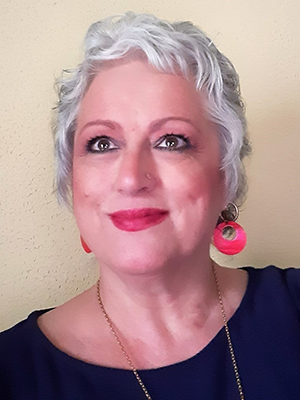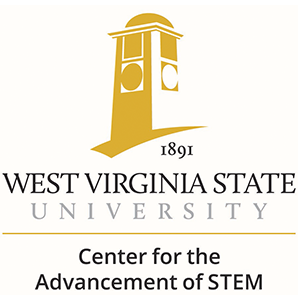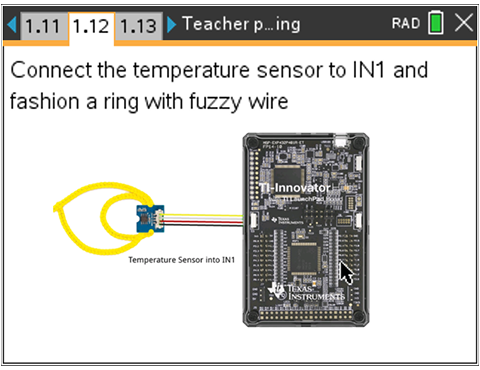TI STEM Camps Open New Doors for Students in Rural West Virginia
The summer of 2020 was filled with uncertainty. Schools had just wrapped up a year disrupted by the COVID-19 pandemic and summer programming was not a high priority for most school districts.
Crystal R. Bishop, a STEM education coordinator at West Virginia State University, wanted to make sure that students had the opportunity to continue learning. She partnered with the STEM Team at Texas Instruments to offer a virtual STEM camp to middle schoolers. Bishop managed all the outreach, marketing, registration, logistics and class management for the camp, and the TI STEM team provided the technology loan and instruction.
The students — majority middle schoolers, 40% girls, 44% from rural schools — designed and programmed a “digital mood ring.” This was all done virtually — over Zoom — and the students used temperature sensors, an RGB (red green blue) LED, a microcontroller (TI‑Innovator™ Hub) and TI calculators to build a device that changed the color of the LED based on their temperature.

The students also wrote code in Python on their calculators as part of this project. There were several challenges — for the students as well as for the organizers — during this virtual summer camp, but the feedback from the students highlighted the value and long-term impact of this hands-on STEM experience.
One of the advantages of the configuration where students wrote code on the TI-Nspire™ CX II graphing calculator was that they didn’t need to switch applications on their computers between listening to the instruction and writing their programs. They also did not need to install any applications on their home PCs. And they didn’t even need PCs to participate. They could connect to the virtual camp through devices like smartphones.
“My interest in STEM has increased because of this experience.” – Sixty-six percent of virtual TI STEM camp participants
A few of the highlights from the student survey are:
- Sixty-six percent of the students agreed that their “interest in STEM has increased because of this experience.”
- Seventy-three percent said that the projects they did “sparked their imagination.”
- Eighty-six percent agreed that they were able to connect the activities they participated in to something outside the classroom such as a real-world concern or issue.
- A third of the students surveyed said, “Participation in this program has me thinking about my future,” and another third said, “I want to learn more about STEM degrees and careers.”
The students also agreed that they learned something new about design, engineering or computer science that they didn’t know earlier.
This virtual camp was so popular that when students were able to participate in person in the summer of 2022, Bishop organized another camp with TI technology. This camp was focused more on strengthening math fundamentals like ratios, rates and proportions.
We wanted to learn more about both these camps and how other educators could conduct similar camps with their students. Bishop shared some of her experiences with us in an email Q&A.*


|
Q&A with
STEM education coordinator |
What’s your role in working with schools and after-school camps?
I am a STEM Educator and NASA Aerospace Education Laboratory (AEL) Coordinator.Tell us about your program and the support you provide to rural districts and students in your area.
West Virginia is a rural state located amid the Appalachian Mountains range in the U.S. It is home to West Virginia State University (WVSU), a historically Black public institution with land grant status. WVSU is “a living laboratory of human relations,” with a community of students, staff and facilities committed to academic growth, service and racial and cultural diversity preservation. WVSU operates the Center for Advancement of STEM (CASTEM) to harness educational and informal opportunities for youth and adults through STEM programming.
WVSU CASTEM provides youth authentic STEM experiences in and out of their NASA Aerospace Education Laboratory (AEL), as well as a mobile creator’s innovation maker space, family involvement curriculum, events, professional development for formal and informal (youth-serving organizations) educators, and community and school outreach. WVSU is the only state in the union with the distinction of operating two NASA AEL spaces: one in Institute, West Virginia, and the other in Beckley, West Virginia.
The NASA AEL was created as one component of an experiential program to provide a technology-rich environment to increase participation and retention of historically underrepresented K–12 youth in STEM fields. Established as a joint venture in 1993 between NASA Glenn Research Center and Cuyahoga Community College, the project grew from a single mobile AEL to a national organization, now called NASA MUREP MAA, and continues to improve children’s academic success nationwide.
What are some common challenges?
Our most significant challenges in implementing quality programming, whether virtual or in person, are access to reliable broadband services and transportation. Both are deficit-based issues originating from poverty and limited resources in rural America.Please share your experience working with TI’s STEM Team and using the STEM projects for your virtual summer camp programs.
We have had two camp program experiences involving Texas Instruments products and personnel; one was virtual and the other in person.
The first camp was our Innovator Hub Club virtual summer camp hosted across West Virginia that focused solely on the TI-Innovator™ Hub and TI-Nspire™ CX II graphing calculator. The youth programmed input and output feedback controls to make the built-in lights on the TI-Innovator™ Hub mimic the colors of a mood ring in the “Digital Mood Ring” activity. Participants explored the science of color and were provided hands-on experience understanding coding concepts of loops, conditional statements and variables. The camp would not have been possible without our partnership with Texas Instruments because they provided the inventory for the students to borrow and the staff to teach the Zoom classes! We provided funding as well as the “legwork.”

The second was this summer’s on-site WVSU STEM Lab Camp, “Does the Monkey Fit?” activity, that explores the design thinking and engineering process. It highlights challenging middle school math concepts, such as real and whole numbers, fractions, decimals, ratios, rates, proportions, percentages, complex expression, and simple equations. To this end, I highly recommend checking out Building Concepts in Math.

Campers were able to complete the activities successfully. Moreover, because the TI‑Nspire™ CX II graphing calculator was also used as an incentive for attendance and participation, youth could take it home to utilize in their academic classes.
What did your students learn from doing the STEM projects?
Our participants loved the virtual camp as we had sent them, on loan, the TI-Nspire™ CX II graphing calculator, the TI-Innovator™ Hub, and sensors before the camp, so it was 100% hands-on learning. They could grasp computer science concepts related to coding such as loops and scientific concepts related to light.In our second camp, students had many opportunities to engage at their own pace and in their way with TI technology. They could perform standard functions like adding, subtracting, dividing, etc. Still, it also allowed them to chart their experiments’ findings and then overlay them to visualize the differences for comparisons. This opportunity deepened their understanding of the initial concept, like what materials performed better given certain conditions.
How has participation in these camps helped your students?
It challenged them! Youth participants told us:| “I liked the camp because it was challenging,” “It allowed me to think outside of the box,” and “I really liked how you had to figure out how to make it work, and they would not tell you how to unless you needed it.” |
They also said the elements of the program that were the most important or interesting were:
| “Creating the mood ring and [being successful in] getting the lights to change,” “Learning how to program the[TI-Innovator™] Hub so that the light would change color depending on the temperature of the room, ice cube, our fingers,” and “the technology and math [were the most interesting things about camp].” |
How can these projects be incorporated into the classroom?
“With TI, calculators aren’t just calculators but excellent investigative tools with large-sized color displays with high-resolution graphics able to operate in some ways as a handheld computer, allowing students to use it in real-world ways.” — Crystal R. Bishop
Under “Next Generation Science Standards” (NGSS), educators are tasked with implementing project-based science and utilizing investigative techniques. In informal learning spaces, authentic learning experiences are intrinsic; therefore, whatever happens, must be real-world related. TI solutions can help provide activities that strengthen science and math skills and enhance soft skills, such as communication and collaboration with their project-based activities. With TI, calculators aren’t just calculators but excellent investigative tools with large-sized color displays with high-resolution graphics able to operate in some ways as a handheld computer allowing students to use it in real-world ways.
Like other calculators, it performs computations, but it also performs functions like plotting multiple graphs and performing data analysis with histograms, pie and bar charts. It even allows you to enter notes or comments. You can hypothesize an experiment and then graphically catalog the data with its science applications. The visualization helps kids understand what is happening with their functions.
What would you need to ensure that every student in your area has these hands-on STEM experiences?
“Collaborating with TI has been instrumental in providing cutting-edge technology to youth in my rural community and state.” — Crystal R. Bishop
Collaboration is the first step in realizing the STEM opportunity experiences. Collaborating with TI has been instrumental in providing cutting-edge technology to youth in my rural community and state.
The second step is to garner the resources that can be shared, like on-demand professional development for the educators or facilitators, the equipment or inventory that youth would utilize, and any other materials to teach or learn, including online resources. Most importantly, a shared network for educators and youth or community of practice allows real-time interactive communication to develop new curricula and uses for the technology.
Did anything during this experience surprise you? (Good or bad?)
I was pleasantly surprised by the infrastructure of TI to assist in planning and implementing virtual programming and camp experiences. I was happy they were willing to work with me to overcome distance/expense by:- Lending me TI calculators/hardware to send to my students across the state for online use that we later returned.
- The professional expertise of their facilitators that implemented the camp.
- Patiently walking us through professional development options and training opportunities —given the different teaching scenarios we experience as formal and informal educators in a variety of settings, including in-school and out-of-school spaces — that are a must to make sure we could accommodate all types of teachers/facilitators.
Please tell us how you plan to use TI’s STEM solutions in your programs.
After using the TI graphing calculators in a summer camp experience, we made a case for funding to purchase two sets of the TI-Nspire™ CX II graphing calculators and the TI-Innovator™ Hub and TI-Innovator™ Hub Rover kit. The kits allow teachers and other informal or out-of-school facilitators to borrow in central and southern West Virginia.What advice would you give to other educators thinking about doing these projects?
“Don’t be afraid to reach out to TI support/personnel; they are there to help, and they will!” — Crystal R. Bishop
As an administrator or project manager, it is a good idea to plan and set aside the funds and the time required for on-site professional development and preparatory practice before the class. In other words, if you are planning a grant, write in these expenses and arrange them in the implementation timeline. As a teacher or facilitator, after receiving the training, give yourself time to practice with the hardware/software before a class or club meeting. And most importantly, don’t be afraid to reach out to TI support/personnel; they are there to help, and they will!

The “Digital Mood Ring” project continues to be a popular project at educator conferences and with students in STEM camps because it covers multiple concepts in coding and physical computing (working with sensors), and it gives the students a chance to customize the project.
There are three different versions that vary in length and emphasis. Educators can choose the version that’s right for them and their students. It’s a very effective introductory project that gives students the fundamentals to tackle some of the more complex STEM projects like “Smart Irrigation.”
In the “Digital Mood Ring,” the students map the sensor readings to different RGB colors on the LED and can add their own messages reflecting different moods. The project can be done on all the TI calculators that work with the TI-Innovator™ Hub. And it can be done using TI-Basic or using Python.

The students also learn important computing concepts like loops, conditional Statements and variables. And the students may not realize it, but they are also learning about “feedback and control” systems and inequalities.
The TI Codes activities are an effective way for students to continue their coding education.
If you would like to have your students build a digital mood ring or do any of the other STEM Projects, please contact your local Education Technology Consultant (ETC) or the TI STEM Team via the TI STEM Projects website.
A special thank you to Michelle Grooms, who was the ETC that worked with Crystal Bishop on this endeavor and facilitated the follow-up email interview.
About the author: Harshal S. Chhaya is a systems engineer for TI’s educational STEM products. He also leads the company’s robotics outreach programs and works with partners to increase student participation in STEM and robotics competitions. Chhaya enjoys using advanced engineering to make education fun and engaging for students and teachers. He holds 13 patents and was elected by his TI peers as a “Distinguished Member of Technical Staff (Emeritus).”
*Responses have been edited to fit the flow of this article.
